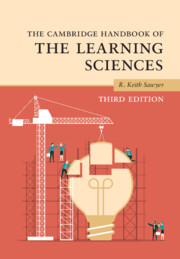Book contents
- The Cambridge Handbook of the Learning Sciences
- The Cambridge Handbook of the Learning Sciences
- Copyright page
- Contents
- Figures
- Tables
- Contributors
- Preface
- 1 An Introduction to the Learning Sciences
- Part I Foundations
- Part II Methodologies
- Part III Grounding Technology in the Learning Sciences
- Part IV Learning Together
- Part V Learning Disciplinary Knowledge
- 23 Research in Mathematics Education
- 24 Science Education and the Learning Sciences
- 25 Complex Systems and the Learning Sciences
- 26 Learning History
- 27 Learning to Be Literate
- 28 Arts Education and the Learning Sciences
- Part VI Moving Learning Sciences Research into the Classroom
- Index
- References
23 - Research in Mathematics Education
What Can It Teach Us about Human Learning?
from Part V - Learning Disciplinary Knowledge
Published online by Cambridge University Press: 14 March 2022
- The Cambridge Handbook of the Learning Sciences
- The Cambridge Handbook of the Learning Sciences
- Copyright page
- Contents
- Figures
- Tables
- Contributors
- Preface
- 1 An Introduction to the Learning Sciences
- Part I Foundations
- Part II Methodologies
- Part III Grounding Technology in the Learning Sciences
- Part IV Learning Together
- Part V Learning Disciplinary Knowledge
- 23 Research in Mathematics Education
- 24 Science Education and the Learning Sciences
- 25 Complex Systems and the Learning Sciences
- 26 Learning History
- 27 Learning to Be Literate
- 28 Arts Education and the Learning Sciences
- Part VI Moving Learning Sciences Research into the Classroom
- Index
- References
Summary
This chapter begins by describing what is unique about mathematics that has made it a central topic in the learning sciences. This research has historically been interdisciplinary, drawing on psychology, mathematics research and theory, and mathematics educators. It then describes two distinct approaches – the acquisitionist and the participationist. The acquisitionist approach considers learning to be what happens when an individual learner acquires mathematical knowledge. This part of the chapter reviews research on misconceptions and conceptual change that has been based in Piaget’s constructivist theories. The participationist approach views learning as originating in social interactions in diverse settings such as classrooms, homes and playgrounds, museums, and workplaces. This approach views learning as a collective sociocultural phenomenon, and uses methodologies such as interaction analysis and design-based research. This chapter concludes with a discussion of how teachers learn to teach mathematics.
Keywords
- Type
- Chapter
- Information
- The Cambridge Handbook of the Learning Sciences , pp. 467 - 485Publisher: Cambridge University PressPrint publication year: 2022
References
- 1
- Cited by

